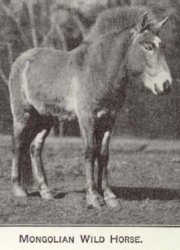© 2000 The American Long Ears Society
All Rights ReservedPrzewalski White
Apparently it's true that inbreeding can eventually cause mutations. The Przewalski horse, the last known "true wild horse" is down to such a tiny gene pool that inbreeding is necessary simply to maintain the breed. In recent generations, white markings never before associated with that breed have begun to crop up. Forehead stars, facial white, socks, white belly splashes - all manifestations of the "crop out" white gene. Somewhere along the way, the genes for color had a mutation, and changes began...in a species where there is no other similar type or species in which to outcrop to, the loss of genetic diversity could eventually mean the loss of the breed.
Additional Notes...
From the book, "The Asiatic Wild Horse" by Dr. Erna Mohr, Translated by Daphne Machin Goodall....
pg 60 - "I know of one wild horse, namely Carlo, bred in Munich who had a small white star between his eyes."

pg 62 - "Neither small marks nor additional lighter spots indicate or are a proof of cross-breeding with domestic horses. In all kinds of wild animals, even in the wild state we find odd colours, whitish, albinos, creams, reds, blacks; even in species that have no domestic counterpart such as bison, deer, hares, moles, monkeys, etc. Because these species show such colour variations, no one would dream of a history of hybridization in the background - nor of saying that the animals are not purebred. There is just little reason to lay particular stress on differences of color or small markings in our carefully bred Asiatic wild horse. Of course they may not represent the ideal picture which we have of wild horses but that is our fault, not the fault of the horses."
Sharon Batteatte's Brindle horse website on Unusual Markings &horse colors has a link to a Fjord horse site, which does mention white markings: www.nfhr.com/Colors.htm
There was also a species of zebra, now extinct, with a "Canary" marking (a white patch) over the shoulders/saddle area. So apparently there are arguments for white markings not being that uncommon in the wild.
(This Page last updated: February 15, 2002)